
INDEX
Arc de Triomphe Arènes de Lutèce Bastille Bateau-Mouche Beaubourg Bois de Boulogne
Bois de Vincennes Parc des Buttes Chaumont Canal Saint-Martin Palais de Chaillot Champ de Mars
Champs-Élysées Île de la Cité Place de la Concorde Île des Cygnes La Défense Tour Eiffel
Place de l’Étoile Charles de Gaulle First Time in Paris? Sainte Geneviève Les Halles Boulevard Haussmann
Historic facts Les Invalides Le Louvre Jardin du Luxembourg La Madeleine Le Marais
Métro Parc Monceau Montmartre Montparnasse Rue Mouffetard Place de la Nation Opéra Garnier
Musée d’Orsay Paris over the years Quartier Latin RATP Revolutions Rue de Rivoli Musée Rodin
Sacré-Coeur Shopping Strasbourg Saint-Denis Saint-Germain-des-Prés Streets, squares and so on
Jardin des Tuileries Place Vendôme Versailles La Villette Place des Vosges

Bastille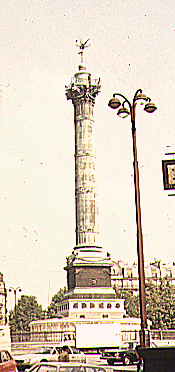
After the Storming of the Bastille in 1789 (see Revolutions) the fortress was pulled down and the stones were carted off to be used for building – the Pont de la Concorde is made of them. The square as it now stands was laid out by Napoleon I in 1803. To the West of the Square, white stones in the roadway mark the place where the original building stood; and in the Metro station a tiny bit of the inner wall of the moat is preserved, along with a permanent exhibition showing what the Bastille used to look like.
In the centre of the square is LA COLONNE DE JUILLET, the July Column. This has nothing to do with the storming of the Bastille in July 1789. It originally commemorated the revolution of July 1830, when Charles X was forced off the throne and Louis-Philippe onto it. On top of the column is, as you might expect, a Statue of Liberty. What you might not expect is that it looks very like Eros. At one side of the base are carved the names of those who died in July 1830 to put Louis-Philippe on the throne. On the other side have been added the names of those who died in the Revolution of July 1848, which put Louis-Philippe off again. It’s a funny old world. The column itself is 170 feet high, and there are 238 steps inside, but you aren’t allowed to go up.
The enormous new building to the North of the Square is the Opéra de la Bastille, which is now the principal Opera House of Paris. I wish I found it interesting enough to write a whole page about, but really that first sentence says it all.
The road leading from the Hôtel de Ville to the Bastille, where most of the people lived who formed that mob in 1789, is the Rue St. Antoine, nowadays a centre of furniture manufacture. In this street in 1559 a tournament was held. King Henri II jousted with a Scottish Knight called Montgomery, whose lance splintered. One of the pieces went through the holes in the King’s visor and through his eye into his brain. He died several days later, but History does not record how they got his helmet off.
Place de la Nation
After the Bastille, the Rue St. Antoine becomes the Rue du Faubourg St. Antoine, and leads to Place de la Nation, the Eastern equivalent of the Étoile. Ten avenues meet here, and in a pond in a wide lawn in the centre is a famous statue of Marianne. Who, I hear you ask, is Marianne? She is the lady who stands for France, just as Britannia stands for Britain. You find her picture on stamps and her bust in Town Halls all over France. You don’t have to go to Place de la Nation to see this statue, though, because there’s a small copy of it on every one-franc piece.
Bateau-Mouche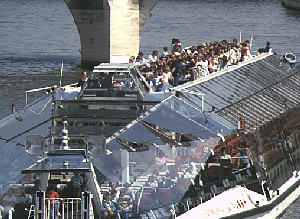
The PONT DE L’ALMA is brand new; but its builders retained the statue of a Zouave from the old bridge, because this gentleman is the measure of Paris floods. The record flood in 1910 came up to his chest. In 1979 it was up to his knees at Easter, and I couldn’t go on the BATEAU-MOUCHE, the biggest of the pleasure-boats on the river, because there was no room under the bridges. The people who run these boats will tell you they’re named after Jean-Sébastien Mouche. This is untrue. The original boats had six oars, and when you looked at them from above (on a bridge, say) they looked like flies (French mouches). A trip on them is mandatory for all visitors, very enjoyable, instructive and very cheap. Accept no expensive imitations.
Beaubourg
Another empty space in the heart of Paris was the PLATEAU DE BEAUBOURG. The late President Pompidou chose this site for his own pet project, a National Arts Centre. The designers were an Anglo-Italian firm working from London, Piano & Rogers. They produced a building consisting of six enormous empty spaces on top of each other, a building that can be adapted to any use its owners might want to make of it. If you want more height, take out a floor. If you want more floors, slot them in. internal walls? Put them where you like. So that the space inside could be entirely empty, all the services, corridors, staircases and lifts had to be on the outside of the building, which is a maze of pipes, ducts, escalators and beams, all colour-coded in bright colours. This is a building you have to either love or hate. I love it. Its official name is CENTRE NATIONAL DES ARTS ET DE LA CULTURE GEORGES POMPIDOU, but the people of Paris call it Beaubourg, because the people of Paris always keep the old name whatever you tell them. Inside are the Museum of Modern Art, several free exhibition halls, an information centre, a fabulous library dealing in books, slides, film, video and microfilm; a cinema, a News Library with all this week’s new books, magazines, TV programmes and records; a children’s Art workshop, a Musical Research Institute and much more. The rooftop café offers good views and some of the cheapest coffee in town. Outside, on the Plateau de Beaubourg itself, there are continual performances by buskers, jugglers, sword-swallowers, fire-eaters, anybody who can do something unusual and hold out a hat.
Bois de Boulogne
Like the Bois de Vincennes (see page 37), this
is a collection of parks set in a wood of 2,000 acres. Two big lakes
with a waterfall between them, two racecourses, another waterfall and
miles of woodland walks. Of the actual parks, the biggest are: Le
Pré Catelan, an informal garden with smooth lawns, including
the Shakespeare Garden, where all the plants and trees are the ones
mentioned in Shakespeare’s plays; Bagatelle, the garden of a
château built, to win a Queen a bet, in 64 days and still
standing - once the home of Sir Richard Wallace, a famous English art
collector, remembered in Paris for the decorative drinking-fountains
he installed over town; and the
JARDIN D’ACCLIMATATION.
 This
is known as ‘Le Paradis des Enfants’, and a children’s paradise it
is. Originally, it was the place where plants and animals new to
France were brought to acclimatise. As new animals are often babies,
it became a sort of kiddies’ zoo, and other attractions have been
built round it. Two adventure playgrounds, a fire-engine and an
aeroplane to play with, a zoo, two farms, distorting mirrors and a
puppet theatre - all these included in the derisory entrance fee of
about 3F. For a little extra there’s a fairground, a magic river,
go-karts, a road-safety training track run by the Police, crazy golf,
a circus and sea-lion performances in summer, pony rides, bowling,
and enough ice-cream, candy-floss, waffles and toffee to make you
sick for a month. All this is approached from Porte Maillot by a ride
through the woods on a miniature train. Just next-door, with an
entrance in the Jardin d’Acclimatation, is the Museum of Popular Arts
and Traditions, sumptuously modern and audio-visual. Also in the Bois
de Boulogne are the Parc des Princes, the Stade Roland Garros and
lots of other sporting facilities.
This
is known as ‘Le Paradis des Enfants’, and a children’s paradise it
is. Originally, it was the place where plants and animals new to
France were brought to acclimatise. As new animals are often babies,
it became a sort of kiddies’ zoo, and other attractions have been
built round it. Two adventure playgrounds, a fire-engine and an
aeroplane to play with, a zoo, two farms, distorting mirrors and a
puppet theatre - all these included in the derisory entrance fee of
about 3F. For a little extra there’s a fairground, a magic river,
go-karts, a road-safety training track run by the Police, crazy golf,
a circus and sea-lion performances in summer, pony rides, bowling,
and enough ice-cream, candy-floss, waffles and toffee to make you
sick for a month. All this is approached from Porte Maillot by a ride
through the woods on a miniature train. Just next-door, with an
entrance in the Jardin d’Acclimatation, is the Museum of Popular Arts
and Traditions, sumptuously modern and audio-visual. Also in the Bois
de Boulogne are the Parc des Princes, the Stade Roland Garros and
lots of other sporting facilities.
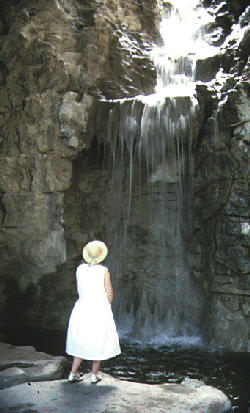
Buttes Chaumont
The Parc des Buttes Chaumont, in the North-East of Paris, not often visited by tourists, is the most spectacular in town. It was converted by Haussmann from an old quarry where the Emperor’s enemies used to meet. On top of the second-highest hill in Paris, it has a lake with an island in the middle 300 feet high, reached by a suspension bridge. There’s a tiny temple on top, with a view of half Paris and the side of the Sacré-Coeur. Down the surrounding hills run cascades and waterfalls. It’s well away from the centre of town, so the people you meet there are guaranteed real Parisians.
The Seine is a very twisty river, and here and there along its course canals have been dug to cut some of the corners. One of these runs clean through the middle of Paris. The Canal Saint-Martin starts opposite the Ile Saint-Louis in the Bassin de l’Arsénal and runs under the Place de la Bastille: it then follows the Boulevard Richard-Lenoir - again under the road. Paris is, in fact, as full of holes as a sponge. Under a single road you can find: SEWERS so big you can go on a boat-trip to see them: RAILWAY or METRO lines - the Metro rarely runs deep, it’s usually just under the road: CANALS like the Canal St.-Martin, taking barges up to 1500 tons: TUNNELS for gas, electricity, water supplies: PNEUMATIQUES, compressed air tubes in which letters are sent across the city: MlNES and QUARRIES - Plaster of Paris is made from gypsum, once mined actually under the streets: CAR-PARKS - under all the main squares and a large number of streets there are vast parking areas: CELLARS and BASEMENTS - both houses and shops have cellars which go not only under the buildings, but under the street as well. The Canal comes out of the ground again at the Quai de Jemappes and runs near the Gare de l’Est and on to La Villette. French canals are BIG, and this one handles barges carrying 1000 tons of sand from the mouth of the seine to the builders of Paris.

This little hill used to have a convent on it, until Napoleon I pulled it down to build a palace for his son, the King of Rome. Nothing was built before Waterloo, except the Pont d’Iéna, the bridge at the foot of the slope. This was named after a victory Napoleon had won against the Prussians, and the Prussians who occupied Paris in 1815 wanted to blow it up, but Louis XVIII wouldn’t let them. In 1837 a square , named Place du Trocadéro after another victory, was laid out on top of the hill. Then for the World Exhibition of 1878 a Moorish Palace was built overlooking the river; and finally that was pulled down and replace in 1937. There’s never a dull moment for builders in Paris. The present building looks like two palaces with a gap in the middle, but the middle bit is just lower than the rest, with its roof level with Place du Trocadéro. From this roof, superb view of the Eiffel Tower and beyond it the Champ de Mars, École Militaire and the Tour du Maine at Montparnasse in the distance. Inside the building are two theatres, an aquarium and three museums; the MUSÉE DES MONUMENTS FRANÇAIS, an architectural museum; the MUSÉE DE LA MARINE, the Navy Museum; and the MUSÉE DE L’HOMME, the museum of Man; how people live all over the world, and how they used to live as well. Beautifully laid out, it’s one of the most attractive museums in Paris.
Beneath, and South of, the Eiffel Tower lies the CHAMP DE MARS. This was once a parade-ground (the field of Mars, God of War), and is now a park. At the end of it is the ÉCOLE MILITAIRE, where the French Army trains its generals. In front of the building is a statue of Marshal Joffre, matching the one of Marshal Foch in the Place du Trocadéro. Both commanded the French Army in the First World war, and much has been made of the fact that they’re pointing in opposite directions.
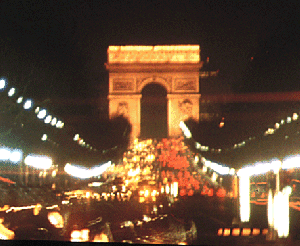
The triumphal avenue, where all France’s great parades, from July 14th to the finish of the Tour de France, are held. Victory parades, too. So far, the French have paraded their armies down here and through the Arch in 1918 and 1945, the Germans in 1870 and 1940.
At the top of the hill at the western end is the Place de l’Étoile Charles de Gaulle
The square on the top of the Chaillot Hill has been known as PLACE DE L’ÉTOILE since the eighteenth century. Étoile means star, and already in those days five avenues met there. In 1854 the square (No.1, below) was redesigned with twelve avenues. In the centre of the star stands the Arc de Triomphe de l’Étoile.
In 1806 Napoleon asked the architect Chalgrin to construct a gigantic triumphal arch in honour of the French Army. The top of the Chaillot hill had to be levelled, and the foundations gave some difficulty, so that by the time the new Empress Marie-Louise arrived in 1810, the arch was only a few feet high. As the Emperor insisted that his bride must drive into Paris through this new gateway, Chalgrin had to get friends from the Theatres of Paris to construct a fake arch of wood and canvas for the occasion. When Napoleon was defeated and exiled in 1814, work stopped, not to be started again till Louis-Philippe ordered it in 1832. It was finished in 1836. In 1840 the body of Napoleon I was carried through in a procession and a snowstorm on its way to the Invalides. In 1854 the twelve avenues were completed by Baron Haussmann. In 1920 the Unknown Soldier was buried under the centre of the Arch. If your grandfather was killed in the First World War - like 1,500,000 other Frenchmen - lay your flowers here. He may be the Unknown Soldier. An everlasting flame on the tomb is rekindled by old soldiers daily.
On the death of President De Gaulle the square was renamed Place Charles de Gaulle, which doesn’t stop Parisians calling it L’Étoile. See how many examples you can find in this book of how people use the old name for a place long after it has been changed. The RATP, in fact, has compromised here and called the metro/RER station ‘Étoile - Charles de Gaulle’.
The Arch forms the focus of La Grande Perspective, which must be the longest urban view in any great city of the world; in one direction the road (Avenue de la Grande Armée) runs out of Paris across the Pont de Neuilly and up to La Grande Arche at La Défense; in the other direction the Avenue des Champs-Élysées runs equally straight to the Place de la Concorde, the Jardin des Tuileries and the Louvre.
The western end of the Champs-Élysées is lined with buildings housing, for the most part, shops, car showrooms, airline offices and prestigious night spots such as the Lido. These stretch as far as the Rond-Point (1 on the plan below).

2) on the plan is the PALAIS DE L’ÉLYSÉE, which is the official home of the President of France. Colourful but casual sentries always on duty.
3) GRAND PALAIS: A large exhibition hall. One side of the building is the PALAIS DE LA DÉCOUVERTE - a Museum of Pure Science belonging to the Ministry of Education.
4) PETIT PALAIS: another exhibition hall. Like the Eiffel Tower, these palaces were built for an International Exhibition - in this case, the one in 1900.
5) Saint Michael’s English Church, strangely but effectively built into the basement of a modern office block.
6) The British Embassy, one of the finest houses in Paris, originally the Hôtel de Charost, bought by the Duke of Wellington from Napoleon’s sister Pauline in 1815. Pauline was one of the most amusing of the Bonapartes. Very pretty and married to Prince Borghese, she once posed nude for a sculptor. When asked if she thought this was really a good idea, she said oh yes, the room was heated and everything.
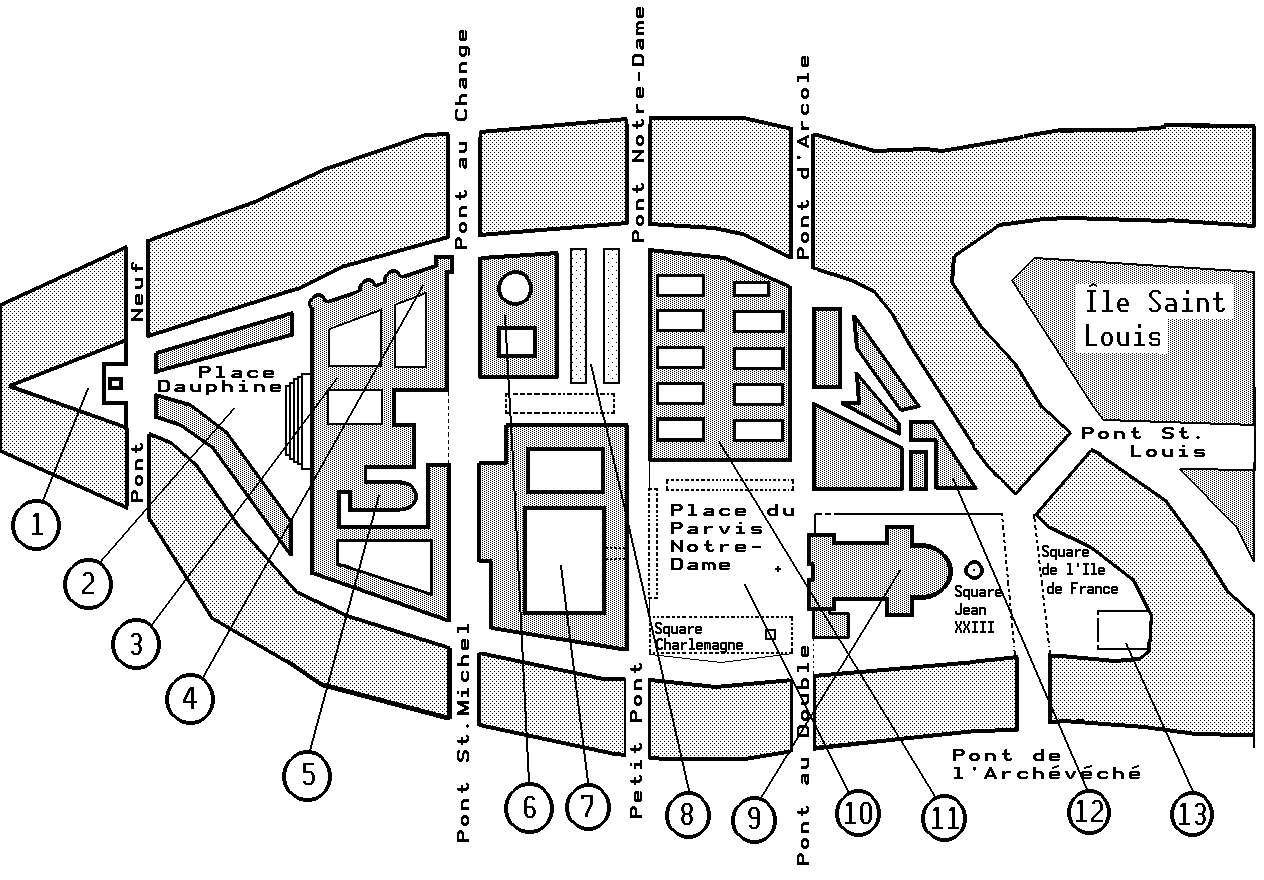
The Island of the City is the oldest part of Paris, and has been inhabited since the Stone Age. The Kings of France lived on the Island until the sixteenth Century. At that time there were several islands where now there are two. In the seventeenth century the Ile de la Cite was joined to a cluster of marshy islands to form the Place Dauphine, and the Pont-Neuf -it means New Bridge, although it’s the oldest bridge still standing - was thrown across the river with its centre on the island. Later another group of islands to the East was made into the Ile St. Louis, and the Ile Louviers was joined to the Right (North) Bank of the river. Notable buildings on the Island:
1: SQUARE DU VERT-GALANT -named after, and overlooked by a statue of, King Henri IV
2: PLACE DAUPHINE - a lovely, tree-lined, quiet little village square.
3: PALAIS DE JUSTICE - the Central Law Courts.
4: The CONCIERGERIE - the oldest part of the Palais de justice; it was first the Palace of the Kings, replacing the original Roman Praetorium: then it became a fortress, then a prison during the Revolution, from which Queen Marie-Antoinette and two thousand others went to the guillotine. There are four towers: the Tour de Cesar, the Tour d’Argent, the Tour Bonbec (which means talkative, because in its torture-chambers people got very talkative), and the Tour de l’Horloge, which houses the oldest public clock in Paris. For some odd French reason, the clock is at the bottom of the tower.
5: SAINTE-CHAPELLE: In the year 1238 Baudouin, a French nobleman and Emperor of Constantinople, was out on the First Crusade and flat broke. To get money he sold the only object of real value he owned, which happened to be the Crown of Thorns.
The pawnbroker sold the crown to King Louis IX of France, who had this chapel built to house it. The Chapel and the golden shrine inside were the cheapest part of the deal, costing less than half the price of the crown. The Chapel was consecrated in l348, and is one of the greatest wonders of Medieval Art. It has practically no walls, the roof being supported on slender pillars between stained-glass windows 50 feet high. Because of the windows, which give you the impression of being inside a coloured thirteenth-century goldfish bowl, this is the most beautiful place in Paris. Nearly all of the glass is original, displaying l,134 different scenes from the Bible. Beneath the Chapel is another, dark and low, for the palace servants. After building this, Louis IX was made a Saint, and serve him right.
6: TRIBUNAL DE COMMERCE: a civil Court.
7: PREFECTURE DE POLICE. For a hundred years the centre of government in Paris was here@ after the siege of Paris in l870 came a revolution called the commune, begun by the People of Paris, and cruelly put down by troops from the rest of France. After that, not until 1977 was Paris allowed its own Mayor and council; it was run entirely by the Police.
8: MARCHÉ AUX FLEURS; on weekdays a flower market, on Sundays a market for all kinds of bird . It’s in the Place Louis Lépine, named after an uncommonly popular police chief.
9 :  The
Eastern end of the Island has been a place of worship for thousands
of years; first a Stone Age Shrine then a small Christian church. in
ll63, when Paris had a population of about 100,000, Bishop Maurice de
Sully laid the foundations of Notre Dame de Paris, which was finished
in l345. Most cathedrals have been added to bit by bit over the
years, but this one was recognised as perfect from the start. over
the years, and especially during the Revolution, it fell into decay,
and was restored by Viollet-le-Duc in 1841-58. The spire and the
gargoyles date from that time. French Kings were never crowned here -
the place for that was Reims. Two Coronations which were held here
were those of Henry VI of England and Napoleon I, who was not a King,
but an Emperor . The towers are 230 feet high, and the view from them
is nearly as good as the view of them.
The
Eastern end of the Island has been a place of worship for thousands
of years; first a Stone Age Shrine then a small Christian church. in
ll63, when Paris had a population of about 100,000, Bishop Maurice de
Sully laid the foundations of Notre Dame de Paris, which was finished
in l345. Most cathedrals have been added to bit by bit over the
years, but this one was recognised as perfect from the start. over
the years, and especially during the Revolution, it fell into decay,
and was restored by Viollet-le-Duc in 1841-58. The spire and the
gargoyles date from that time. French Kings were never crowned here -
the place for that was Reims. Two Coronations which were held here
were those of Henry VI of England and Napoleon I, who was not a King,
but an Emperor . The towers are 230 feet high, and the view from them
is nearly as good as the view of them.
10: PLACE DU PARVlS NOTRE-DAME - the vast open space in front of the cathedral. There used to be streets here; the outlines of the buildings are marked on the ground. Beneath is an underground car-park, and a museum showing Roman remains found when the car-park was being dug. From a brass plate in this square, the official centre of Paris, all road distances in France are measured.
11: HOTEL-DIEU: the oldest Hospital in Paris.
12: CLOITRE NOTRE-DAME: all that remains of the maze of medieval houses that once covered the whole island.
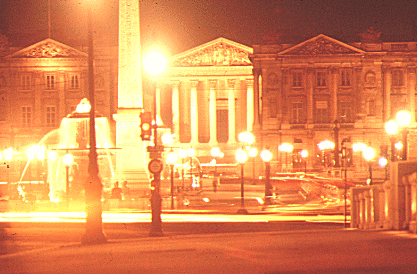
This great square was originally designed by Gabriel to be a present from the people of Paris to King Louis XV, at that time known as Louis the Well-Beloved. He created a 21-acre octagon surrounded by a dry moat, with a statue of the King in the centre. At intervals around the moat were statues representing the chief towns of France, and the centre of the square was reached by four bridges. Amusingly, the squatters of Paris soon discovered that the pedestals of the statues were hollow, and they moved in, hanging out washing and growing vegetables in the moat. In 1770, however, the crowd in the square panicked during a firework display held to celebrate the wedding of the King’s son. 133 people were crushed to death in the moat, which had to be filled in.
During the Reign of Terror the Square’s name was changed from Place Louis XV to Place de la Révolution, and 1,343 people were guillotined there, starting with Louis XVI. After that, the square was given its present name (Concord means Peace and Harmony), and the bridge across the river was built with stones taken from the demolished Bastille. In the reign of Louis-Philippe the square was completed by an architect named Hittorff, who added the fountains and brought from the ruined palace of Marly the statues at the entrances of the Tuileries gardens (‘Winged Horses’ by Coustou) and the Champs-Élysées (‘Horse-tamers’ by Coysevox). The Obelisk in the centre of the square was a gift to the people of France from Mohammed Ali, Pasha of Egypt. It is 3,300 years old and weighs 2,200 tons. Around the base of the obelisk, which came from the Temple of Luxor, are carvings representing the machines used to bring it to Paris and set it up (Cleopatra’s needle, you may remember, was both broken and lost at sea on its way to London, so the French engineers had something to crow about).
The two vast buildings to the North of the square are part of Gabriel’s original plan. The Western one, now the Hôtel Crillon, was originally palaces for several noblemen; the other, now the Navy Ministry, was the royal furniture store. The Kings, you see, had about fifty palaces and châteaux; rather than keep them all furnished all the time, they kept the furniture in a central store and sent it out as needed.
The Île des Cygnes is a long, narrow artificial island near the Eiffel Tower, with things worth seeing at each end. At the North end is the PONT DE BIR-HAKEIM, originally the Viaduc de Passy. It is a double-decker bridge, and ordinary stone bridge with another iron one built on top to take the metro. This particular line runs round the North of Paris and is built for long stretches on a continuous bridge above the boulevards; which is why it’s called the Metro and not the Underground.
At the other end of the island is the Statue of Liberty. Not the original, no. The French offered the big statue to the USA for giving them the idea of having a Revolution. It was designed by a sculptor called Bartholdi and cast in sections in his studio. (When they put it together they had to take the roof off.) The original model, six feet tall, is in the Musée des Techniques. Then the bits went off to New York and were assembled at the entrance of the harbour. In return, the Americans made a thirty-foot copy and sent it to France, where it stands here at the entrance to the port of Paris - a busy harbour, though it takes only barges.
Opposite the Île des Cygnes on the right bank is the Maison de l’ORTF, the French TV centre. On the other side is the Front de Seine development, a tower-block village where the entrances all open onto an esplanade which is at second-floor level and thus traffic-free.
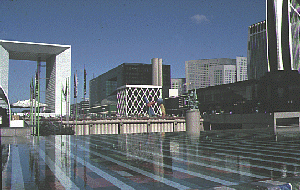
This new town stands at the end of the Grande Perspective. From its terraces you can see straight across the river and through Paris past the Arc de Triomphe, Place de la Concorde and the Tuileries to the Louvre - given a clear day and a pair of binoculars.
Originally there was a bare hilltop here, crowned by a statue commemorating the Defence of Paris in the war of 1870. The statue is still there, but around it has grown a town of the 21st century, where people live and work high in the air, work forty floors up in the building opposite, shop underground and take their ease at ground level. All the roads and public transport are underground, too.
After long deliberation about what to put at the end of the Grande Perspective - a vast mirror was suggested at one time - LA GRANDE ARCHE has now been completed. This is not an arch at all, but a cube 100 metres long, wide and high, with a hole through the middle and glass lifts up its centre. In front of the cube is a wide open space with trees, a market, the great view back into Paris, and a fountain 60 metres long whose water, electronically controlled, dances to music on summer evenings.
Also not to be missed at La Défense: the CNIT (Centre Nationale de l’Industrie et de la Technologie), one of the first buildings to go up, consisting of a triangular curved concrete slab touching the ground only at its corners. This is now the showcase of the French Computer industry. LES QUATRE TEMPS is the shopping centre, on three levels (two underground), a whole series of interconnecting malls with large squares each with its architectural feature. as it serves a suburb rather than the capital, it’s not an expensive place to shop. Look out, too, for the sculptures on the esplanade. The brightly-coloured one is by Miro, the biggest by Calder, who invented the Mobile. As this one doesn’t move, it’s called Stabile. There are about forty other sculptures around La Défense, and you can get a brochure about them from the Information Centre near the cube. A good way of spending an afternoon is to start at Pont de Neuilly at the end of the metro line, walk up the succession of terraces to the top, check out the architecture and sculpture, shop and eat in Quatre Temps, and go home on the RER.

When built: 1887-1889
Why: International Exhibition; France to have the world’s tallest building.
Designed by Gustave Eiffel, a bridge builder. The plans covered 6,000 square metres of paper.
How built; in a factory, then put together on the site like a giant Meccano set by 300 builder. Held together by 2,500,000 rivets.
PRICE: exactly 1 franc per kilogram.
WEIGHT: 7,000 tons, putting a pressure on the ground of 56 lbs per square inch - less than a man sitting on a chair. A scale model a foot high would weigh a quarter of an ounce (7 grams).
HEIGHT: Originally 984 feet; now, with TV mast, 1.058 feet.
EXPANSION: the tower is 6 inches higher on a very hot day.
SWAY: only 5 inches in the strongest winds. PLATFORMS: at 187 feet, 377 feat, 898 feet.
Going up the tower is not compulsory for visitors to Paris. The view from the top is over-rated. I recommend the second floor. Go up by lift, walk down the stairs.
VIEW from the top on a clear day, 42 miles.
First time in Paris? Booked into a hotel? There are a few things it’s useful to know in advance. First, most Paris Hotels don’t have a restaurant. Many haven’t even a breakfast-room, so your breakfast is served in your bedroom. They actually apologise for this. Even where there is a breakfast room, it’s never big enough for all the guests at once, so if you’re late (which means after eight) you may have to queue. Standard breakfast consists of bread, butter, jam and a croissant. Coffee is the normal drink, but chocolate, milk or tea will be no problem.
The standard Paris hotel consists of a central stair-well with rooms all round it on each floor. There’s always a lift, often a two-person affair, and a WC (marked ‘WC’) on each landing. Some rooms will have private facilities, but not all; the proportion of such rooms determines the number of stars the hotel gets. Two-star doesn’t mean more comfortable than one-star; merely that more of the rooms have private baths.
PILLOWS: on each bed will be a traversin, a bit like a fat sausage, rolled in the bottom sheet. Occasionally there is also an oreiller, a large square floppy pillow. Sometimes there’s a spare one in the wardrobe. This is standard equipment for French beds; make the best use of them you can.
WINDOWS: All windows in France open inwards, and have three positions; shut, wide open and a third position in which you shut the side with the bolt and trap the other side under the handle. This gives good night-time ventilation, but negates the sound-proofing of any double-glazing that may be installed.
Once upon a time there was a Cemetery, called the Cemetery of the Innocents b because its church was dedicated to the Holy Innocents, the children killed by Herod after the birth of Jesus. It was just outside Paris. Then the city grew and engulfed it. By 1785 there were more dead people in Paris than live ones. At the side of the cemetery was a charnel-house, a place where bones were put when a grave was opened because, through lack of space, it had to be re-used. (This is still standard practice in France, where the basic plot in a cemetery is sold for a five-year term.) Near the charnel-house was a drinking-fountain, the Fontaine des Innocents. Opposite was a church, Saint-Eustache. In 1785 the charnel-house was pulled down and the cemetery dug over. 1,200,000 skeletons were removed and taken across town to the Catacombs. The site then became the central food market of Paris. Under Napoleon III the architect Baltard built a cast-iron covered market there, known as LES HALLES.
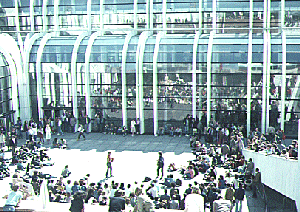 By 1968, this market was too small and too
central to cope with the needs of six million Parisians, and it was
moved out to Rungis, in the southern suburbs, leaving behind it a
vast empty space in the heart of Paris. The argument over what to do
with it went on for the next twenty years. First, the whole site was
excavated to a depth of eighty feet, producing the largest hole in
Europe. In this space were installed seven underground floors of
shops, offices, car-parks and stations. The nucleus of the shopping
centre, LE FORUM DES HALLES, opened in September 1979. It is on
several floors, from the level of the metro station upwards, drawing
light from a deep central well a hundred feet across. As well as some
very expensive shops there are cafés and cinemas, and in the
central space there are usually open-air performances going
on.
By 1968, this market was too small and too
central to cope with the needs of six million Parisians, and it was
moved out to Rungis, in the southern suburbs, leaving behind it a
vast empty space in the heart of Paris. The argument over what to do
with it went on for the next twenty years. First, the whole site was
excavated to a depth of eighty feet, producing the largest hole in
Europe. In this space were installed seven underground floors of
shops, offices, car-parks and stations. The nucleus of the shopping
centre, LE FORUM DES HALLES, opened in September 1979. It is on
several floors, from the level of the metro station upwards, drawing
light from a deep central well a hundred feet across. As well as some
very expensive shops there are cafés and cinemas, and in the
central space there are usually open-air performances going
on.
The rest of the space took another ten years to develop, mostly spent in argument over whether there should be skyscrapers. In the end, there is a new park, its alleyways named after poets, its entrances built of iron in the style of Baltard. It includes a children’s playground which look fabulous, but on which I am unable to report because adults are not allowed in. Underneath it, more shops, a library, a sports complex including swimming pools and billiard halls (not snooker, though; French billiard tables have no pockets), and Jacques Cousteau’s Ocean World.
At the North side of the park a sort of arena faces the church of Saint Eustache, an oddity among buildings. If you simplify the principles of architecture, you can recognise several styles as follows: Greek - pillars and cross-beams; Romanesque - round arches; Gothic - great heart and pointed arches. Saint-Eustache, which was built at a moment when fashions were changing, has great height, round arches, and a façade with pillars and cross-beams. Inside, however - and it’s very spectacular inside - don’t miss ‘Le Départ des Halles’, a colourful sculpture showing all the market-people packing up and moving out in 1968.
Baron Haussmann has been described as ‘The man who created Paris’. He has also been called ‘the man who destroyed Paris’.
The Second Empire lasted from 1852 to 1870. Napoleon III wanted to modernise his capital, and at the same time to make revolutions impossible. Having led a successful revolution himself, he knew what was needed; broad avenues instead of little narrow streets. Then rebels couldn’t block the streets with barricades; troops could be rushed across the city when needed; artillery could command long fields of fire, and the cavalry could get a good run at the mob.
Baron Haussmann was appointed Prefect of the Seine, which meant Boss of Paris, and set to work on reconstruction. He had broad streets built in all the gaps where old city walls had been, and others running across town between them and meeting in grand squares. He converted all the waste ground where plotters met into parks, and generally streamlined and updated everything. The ring roads where walls had been he called Boulevards. The streets themselves here are very broad, the pavements even broader; there are rows of trees for shade, and the buildings on either side were limited by law to a height of six stories (not counting the basement and the roof, which often contains another two floors). These new streets soon became the centre of Parisian life, and so the great Department stores sprang up along them, especially on the Boulevard Haussmann, where two stores - PRINTEMPS and GALERIES LAFAYETTE - have domes designed by Gustave Eiffel, and roof-gardens with interesting views. For more details, see SHOPPING.
Incidentally, the scheme worked. No revolution has succeeded on the streets of Paris since.
SAINT LOUIS (Louis IX) born 1214; King 1226-1270. Crusader (hence sainthood). Built the Sainte-Chapelle to house the Crown of Thorns.
JOAN OF ARC Born 1412, when the Hundred Years’ War was in full swing. Age 13, heard voices telling her to lead the French army to victory over the English and crown the King at Reims. Not an easy job for a peasant girl. Went to Chinon, saw King, was given army, relieved Orleans, took King to Reims and had him crowned. After that, it all went wrong. Got into trouble with Church for dressing up as a man and claiming her voices came from God. Captured by troops of Burgundy, sold to English, tried for heresy, burned at Rouen 1431. Declared a Saint in 1920. Quite a lady.
FRANÇOIS I 1515-1547; allied with Henry VIII of England against Spain; patron of the arts, fond of luxury, started the Louvre. Like most people, fell out with Henry VIII.
HENRI IV 1589-1610; ended Wars of Religion by turning Catholic, thus puzzling both sides so much they stopped fighting. Paris, he said, was worth a Mass. Lots of lady-friends. Wanted every French family to have a chicken in the pot every Sunday. Best King France ever had. Murdered by Ravaillac, a mad monk, who met a sticky end (see page 23).
Louis XIV, le Roi Soleil 1643-1715; the most absolute of monarchs. Built Versailles and lots of other places. Reign famous for culture and glory, but hard on starving peasants.
Louis XV Came to throne 1715, died 1774. Great rejoicing on both occasions.
NOTE that from 1610 to 1774 France had only 3 Kings.
LOUIS XVI 1774-1792; not much of a King, but both indecisive and pig-headed. Married to Marie-Antoinette, the original dumb blonde. After Revolution, tried for treason. Guilty. Chopped.
NAPOLEON I Born near Ajaccio, Corsica, 1769. Educated at Military Academy in Brienne, École Militaire, Paris (Report: ‘This cadet shows no special promise, and should join the Navy’). Joined the Artillery, used his guns to chase the English out of Toulon. Promoted from Captain to General. Conquered Italy, then Egypt. Turned to politics 1798, won more battles, Consul for life by 1802. Introduced new code of law, financial system, education system, went on winning battles. 1804, Emperor. Defeated all Europe except Britain and Russia. 1812, tried to conquer Russia while fighting Britain in Spain. Lost army of 300,000 in Russian winter. Defeated by European coalition 1814. Exiled to Elba (tiny island to left of Italy). 1815, nipped back to France in little boat. Had to be re-clobbered, properly, at Waterloo. Exiled to St. Helena (tiny island 100 miles to left of nowhere). Died 1821. Buried Invalides, Paris, 1840. France still administered by his system.
Louis XVIII; known to his mates as Fat Old Louis. Brother of Louis XVI, escaped Revolution, became King 1814. Took number XVIII because XVII had died while France was doing without a King. Ran away in 1815, came back after Waterloo. Never really did anything else.
Napoleon III; great-nephew of I; President of Second Republic 1848, proclaimed Second Empire 1852. Took number III because II had died while France was doing without an Emperor. Rebuilt Paris. Tricked into war with Prussia 1870, lost, abdicated, died in England. Only son killed in Zulu war, so no Napoleon IV.
The HÔTEL NATIONAL DES INVALIDES was built as a barracks for 7,000 men - mostly old wounded soldiers - in the reign of Louis XIV.
It now houses about 100 old codgers, part of the Army Headquarters, and an enormous Military Museum. The main courtyard, lined with old guns under a grand arcade, is overlooked by the most famous statue of Napoleon, the one known as ‘Le Petit Caporal’ - enormous hat, brooding expression, hand on wallet, The Museum, which occupies most of the left-hand side of the building, spreads over several floors, and traces the French Army from the Middle Ages to Vietnam. Don’t miss the top floor, Le Musée des Plans-reliefs, where there are vast three-dimensional models of fortified towns and battlefields. Observe, too, a strange anomaly. Young people in full-time education are entitled to free entry to all Museums belonging to the state; but Les Invalides belongs to the Army, so you have to pay.
In the centre of Les Invalides you will find two churches, back-to-back; St. Louis’ and the Dome. Captured flags hang in St. Louis’; there used to be thousands more, but they were burned to prevent their recapture in 1814.
Under the Dome, in a crypt specially dug and taking up nearly all the floor space, lie the remains of Napoleon I, brought back from St. Helena in 1840. The body is in a tin coffin inside an iron coffin in a mahogany coffin in a lead coffin in another lead coffin in an ebony coffin in an oak coffin in a five-ton red porphyry sarcophagus on a green granite base. That lot ought to hold the little blighter down. Around him are the tombs of his son and the Marshals of France.
The other great claim to fame of Les Invalides is that the French Revolution started here, because it was here that the mob came to steal weapons for the storming of the Bastille. The whole story - Governor’s daughter forced to drink cup of blood, and so on - is told at the ‘Son et Lumière’ performance twice nightly - once in French, once in English.
What is Son et Lumière? Well, it means
Sound and Light. A play performed by voices and lights. Invisible
marching soldiers tramp across the courtyard; the flames of
revolution light up the dome. Stirring and impressive stuff, and the
performance at Les Invalides was the first of its kind. It tells the
story of Napoleon, and manages to do it without once mentioning
Waterloo. 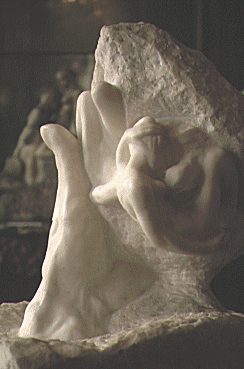
In front of Les Invalides is the ESPLANADE, a vast open space originally a parade-ground, now laid out as a rather formal park - with the mandatory underground car-park beneath. Notice the old cannon round the entrance, and the two German tanks captured on Place de la Concorde in the battle of Paris in 1944. At the other end is Pont Alexandre III, an iron bridge of a single span, named after the Czar of Russia in 1900 and bristling with statuary of all kinds.
Across the road from les Invalides and just into the district of Saint-Germain is the MUSÉE RODIN, housed in the Hôtel Biron, one of the old aristocratic houses of the left bank. These old houses present mere blank walls to the outside world, but within the enclosure is a delightful, airy house with vast French windows opening the whole place up to a quiet, secluded country garden. Rodin’s sculptures are displayed in both house and garden, and it’s a place not to miss. I particularly like the small marbles, like The Hand of God (right)
LOUVRE is probably a shortened form of ‘La Louverie’, the wolf’s lair.
It is not known whether this name was the king’s boast of his subjects’ complaint. Probably, knowing Parisians, the latter.
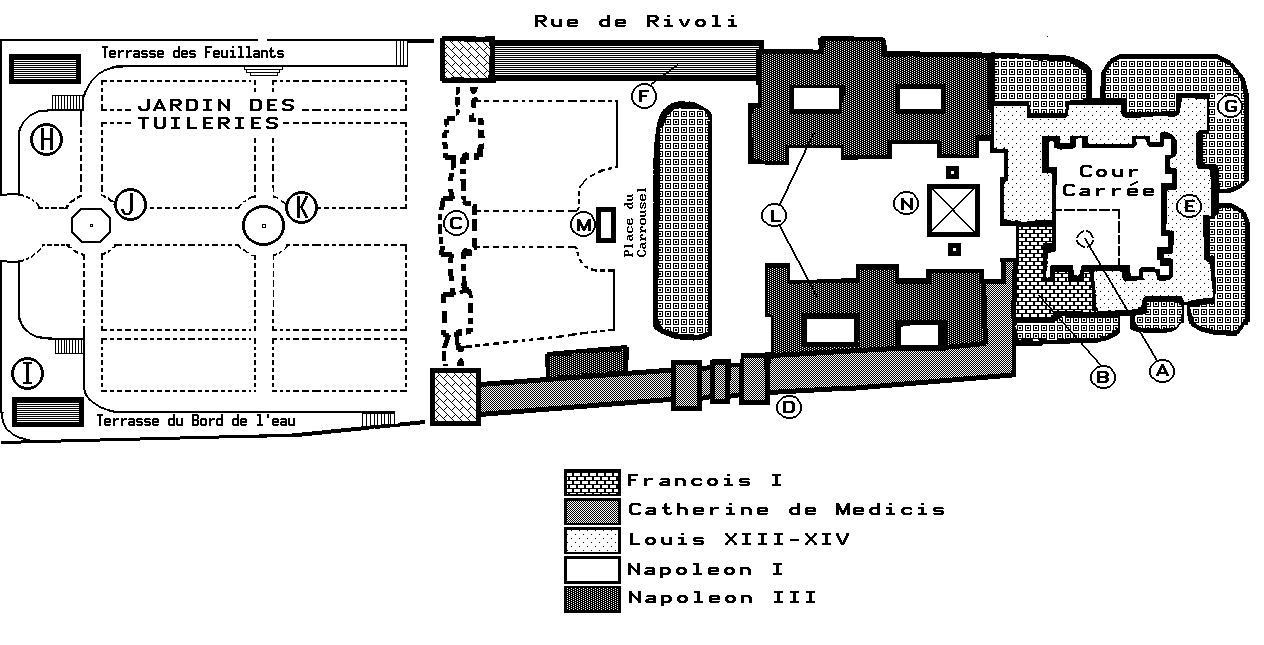
The first castle here was built in 1200, on the site marked at A. Its foundations can still be visited since the new entrance tunnels to the Louvre Museum include the basement levels of all the former buildings. François I (1515-1547) knocked it down and built a nice, new, L-shaped palace (B).
In 1563 Queen Catherine de Médicis pulled down an old tile-factory (Tuilerie) six streets away to the East (C) and built a new palace called the Palais des Tuileries. About 1600, she noticed she was getting wet walking through the streets from her own palace to the King’s, so she began the Galerie du Bord de l’Eau to join them together (D). This meant a new building larger than the other two put together, since it had to be a quarter of a mile long and two stories high to bridge over the streets in between.
Under Louis XIII and XIV - which means from 1610 to 1715 - The Cour Carrée (E) multiplied the size of the original Louvre by four. At this point, Louis XIV decided the Louvre was far too small, and moved out to Versailles. The building became derelict and squatters moved in. At this stage, remember, the buildings of the Louvre were still in among the city streets. During the Revolution (1791) Louis XVI was forced to move back into the Tuileries, and then Napoleon I lived there. He added enormously to the original Art collection of François I. (It’s easy to collect Art if you’re a conquering Emperor, you just nick all the best stuff as you go along.) He had the Louvre restored to hold all this loot, and began a new gallery (F) along his new main street, Rue de Rivoli.
The job was finished by Napoleon III, who still lived in the Tuileries and let the public into the Louvre to see the Art collection. He also added the two bits marked L, designed to conceal the fact that the two long galleries aren’t parallel. The whole job was finished, and all the streets in the middle demolished, by 1865; just in time for the fall of the Empire in 1870. During the suppression of the Commune in 1871, some twit burned down the Tuileries Palace. Obviously a serendipitous twit, however, because in so doing he opened up one of the most spectacular urban views in the world, La Grande Perspective; three straight miles from the Louvre to the Arc de Triomphe.
In the middle of the open space between the arms of the Louvre is the Arc de Triomphe du Carrousel (M), commemorating Napoleon’s Austrian campaigns, with an inscription explaining why he had to go off and take Vienna instead of invading England. Originally it had on its top the four bronze horses from St. Mark’s Cathedral in Venice, but when Napoleon was finally defeated, the Venetians took them back.
The Louvre continues to develop; the moat (G) at the Eastern end dates from the 1960s, when it was dug to show off the proportions of the colonnade; and at the very heart of the building is the new glass pyramid designed by I.M.Pei to form the entrance to Le Grand Louvre. Until now, the Louvre has not been all one Museum; a third of it, for example, was the Ministry of Finance. The pyramid leads to a series of underground entrances to the whole building. When the thing’s finished, there will be ten miles of galleries; not a Museum you can nip round in half an hour. There are actually six sections; Greek & Roman Antiquities, Egyptian Antiquities, Oriental Antiquities; Sculpture; Paintings; and other works of Art and furniture.
Many guide-books go on and on about the Louvre; I have one from 1885 which gives it 150 pages, and the rest of Paris 50. But in a miniguide like this, that’s your lot. You want to know more, buy a separate book.
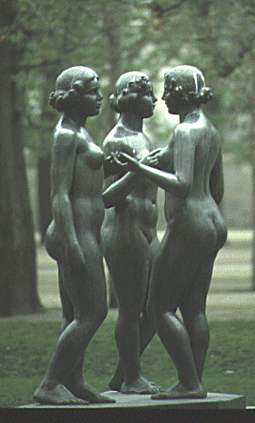
This garden and the raised terraces along each side were designed in 1664 by Le Nôtre as practice for Versailles. The park has always been open to the public, though the terrace beside the river used to be reserved for the royal children. It’s a good example of a French 17th-century garden, what with statues and fountains and Keep off the Grass, though it was considerably remodelled in 1989. Still, the park offers some fabulous views through the heart of Paris, being part of the Grande Perspective. It has two ponds, one octagonal (J on the plan) and one round (k); you can hire model boats to sail on either of them, and the fountain in the middle will wash your boat back to the edge if the wind dies. Nearer the Louvre is a fine group of bronze statues of chunky ladies by Maillol.
H and I on the plan are two buildings now used as Art Galleries. H is the Jeu de Paume, once an indoor court for Real Tennis - a bit like double-ended squash - and I is the Orangerie, a sort of greenhouse where orange trees were kept in the winter. In the summer they stood around the gardens, in case anyone got thirsty.
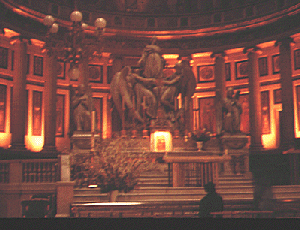
Work began at the top of the Rue Royale, North of Place de la Concorde, in 1734. a fairly run-of-the-mill Renaissance church was planned. In 1777, however, the architect died, and his successor decide to pull down what had been built so far and put up a Classical Stock Exchange instead. This project ran into difficulties, and the plans were altered in turn to suit a Library, a Parliament building, a Court house, and a Bank. In 1806 Napoleon had it all pulled down and ran a competition to design a replacement which would be a Temple to the Glory of the French Army. The design which won the competition didn’t suit Napoleon, so he asked Vignon (one of the judges) to do the job. Vignon produced the final design, an enormous Greek Temple surrounded by 52 pillars each 65 feet high. After the fall of Napoleon, Louis XVIII ordered the builders to carry on with the job, but to make it a church. In 1841 the building, almost finished, was nearly turned into Paris’ first railway-station, but it was finally consecrated in 1842 as the Church of Saint Mary Magdalene - La Madeleine.
Inside it’s very cool, rich and highly decorated, all silver and gold. Under that ordinary-looking roof there are three domes. The church is now famous for its music.
UN MARAIS is a marsh. This particular marsh was drained in the 15th century, but that doesn’t change the name. It was built over during the next hundred years, and the buildings that went up then set the pattern for Paris housing for centuries to come. Instead o the poor people living at one end of the town and the rich at the other, here the social structure was vertical. The ground floor was for stables, storerooms and the CONCIERGE - the caretaker, usually an old lady with a cat, who cleans the entrance and staircase, distributes the mail, and opens the door to residents and visitors by means of a lever in her private room. If you arrive during the night, she can look through a peep-hole to make sure you’re not a burglar, and pull the lever - or nowadays press a button - to let you in, all without getting out of bed.
The first floor - out of the muck of the street, but only one flight of stairs to climb - had high ceilings, vast rooms and balconies, and was where the rich people lived. From there upwards the more stairs you climbed, the less rent you paid. Cheapest of all was the MANSARDE, a space in the roof, boiling in summer and freezing in winter. Above that was the hayloft, with a crane to raise and lower the hay according to the needs of the horses. This would overlook the inner courtyard, and nowadays it’s much used for shopping baskets, because people still live in those garrets.
Some of the larger houses have been restored and are museums. The MUSÉE CARNAVALET is a Museum of the History of Paris. Others house the National Library, the National Archives and so on. Especially worth seeing are Hôtel de Sens, Hôtel d’Aumont and Hôtel Sully. Among the most recently restored is the Hôtel Salé, built in 1656 for the man then responsible for collecting the salt tax. This is now the Picasso Museum, and well worth a visit for its building, its exhibits and its contrasts.
 Parc Monceau
Parc Monceau The area of Paris North of the Champs-Élysées is seldom visited, because it’s essentially a place where people live. The western half of the area includes some of the largest and most elegant private town houses in the world. Parc Monceau, at the end of a very smart avenue leading from the Arc de Triomphe, suits these surroundings. The railings are gilded, the gates look like those of a palace, the public loo is in an 18th-century rotunda. There are lots of statues, a waterfall, the usual sandpit and slide with elegant benches for nannies, and a Naumachia - a pond surrounded by a colonnade, of a type on which Ancient Romans used to fight mock battles with galleys. This one, though, was built as a ready-made ruin by Haussmann in 1860.
East of the Parc is Batignolles, a working-class district with a number of small hotels and its own park, recently restored and delightful in its own way. The pond has a sculptured rock in it, with sculptured birds; and the miniature cascade is a triumph of the rock-gardener’s art.
The Hill of Monmartre - La Butte - was far outside the walls of Paris until the nineteenth century. Its name probably comes from a Roman Temple of Mercury (Mons Mercurii); but an old legend makes it the Mount of Martyrs. The story goes that Saint Denis, Patron Saint of France, was Bishop of Paris during one of the last waves of persecution before the Roman Empire became, at least officially, Christian. Bishops always being first on the chopping list, he was taken to the top of the hill, along with two saintly chums, to have his head removed. For some reason he objected, not to the programme but to the venue; preferring to be executed - and buried - in a village three miles further North. The executioner expressed his deep regret at his unfortunate ability to comply - or words to that effect - and did the job where he was. Whereupon Denis stood up, picked up his head, and marched off to the North to get himself buried. Although the grave is still there as evidence, it is only fair to point out that not a lot of people actually believe this story. The village around the tomb, however, now a large town, is still called Saint-Denis; the basilica there was for centuries the burial-place of the Kings of France. And in stained-glass windows it’s always easy to spot which Saint is Denis; he’s the one with ‘is ‘ead in ‘is ‘and.
Montmartre itself developed over the years as a village with steep, winding streets, many composed entirely of steps, leading up to what is now the highest point in Paris. It was from the earliest times a favourite place for artists, notably - at the end of the last century - the Impressionists. Round the base of the hill, dance-halls and night-clubs grew up, creating - with the help of the artists - the whole legend of ‘Gay Paree’. The night-clubs are still there, in the Place Pigalle and Place Blanche and round about. Pigalle, at the end of the Second World War, was an area reserved for American Army officers, and so well guarded by Military Police that the GIs called it ‘Pig Alley’. In Place Blanche is the most famous of all the night-spots, and the oldest though its building is new; the Moulin Rouge. The name means the red mill; the hill of Montmartre was once covered with windmills, some like this one converted to dance halls. The imitation mill in Place Blanche is one of only two remaining. The independent Commune of Montmartre claims that it mills its own flour and grows its own wine - in Paris’ only vineyard. A few bottles a year, that’s all, and ninety percent vinegar.
As the night-clubs began to attract tourists, prices went up in Montmartre and the artists moved out, mainly to Montparnasse; but painters can still be seen exhibiting their work for tourists in the Place du Tertre. If you want a quick portrait or silhouette of yourself, this is the place; as it is for imitation Rembrandts and sentimentalised views of Old Paris. The quality of the paintings is by no means always as high as the prices.
Poets and artists are nearly always poor. Young ones very poor. Time was when they couldn’t even afford to live in the Quartier Latin, but had to find cheap lodgings near the rubbish dump.
Inspiration for poets and artists is supposed to come from the nine Muses, who lived on Mount Parnassus in Ancient Greece.
Which is how the tallest of the rubbish-heaps came to be known as Montparnasse. Even into this century, by which time the hill in question had a railway station on top, Montparnasse was where writers and artists gathered. Now the area has been dug over and a new complex built. The station is underground now, so there can be no repetition of the moment in the 1890s when a train failed to stop, went through the buffers, across the platform, through the stationmaster’s office and came to rest hanging out of the window six floors above the street. Nobody was hurt. Above ground is a shopping centre, a large residential development of the most criminal ugliness, and an office block 656 feet high, called the Tour du Maine, with quite a view from the 56th floor. The shopping centre has branches of Galeries Lafayette, C & A, Habitat and Jimbo. You can tell which floor you’re on by the colour of the carpet, and the third basement, level with the metro, has a swimming bath with three pools.
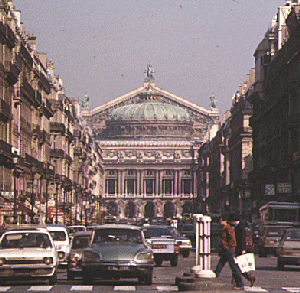
When Napoleon III made himself Emperor in 1852, he decided to have a new Opera House built. Only in 1860, however, was a competition held to choose an architect. The winner was a very young man named CHARLES GARNIER, who tried to create a new Second Empire style. Lots of his original drawings and models are in the Museum of the 19th Century at the Gare d’Orsay.
Originally called the Académie Nationale de la Musique, this is still the world’s largest theatre, though it holds a mere 2,200 spectators. The enormous stage (far, far bigger than the auditorium), palatial dressing-rooms, lobbies and staircases take up between them well over three-quarters of the building. ‘Phantom of the Opera’ fans will be pleased to know that there is a lake of sorts under the building - it’s built over an ancient river.
From the start, only Grand Opera - in which all the words are sung and none spoken - was permitted here. In its heyday, the Opera employed a permanent staff of over a thousand. The interior, designed for an Emperor’s entertainment, is amazingly grand, but the audience had a reputation as the world’s rudest.
Nowadays, since the building of the new Opera House at the Bastille, Garnier’s masterpiece is used only for ballet; but because it’s not so busy there are now guided tours during the day. In the old days, the only way in was to buy a ticket for a performance. There’s a little museum as well.
In front of the building is the Place de l’Opéra, once the centre of fashionable Paris, from which the Avenue de l’Opéra leads down to the Comédie-française (the National Theatre) and the Louvre, and the Rue de la Paix (Mayfair in French Monopoly), with its jewellers’ shops, leads to Place Vendôme.
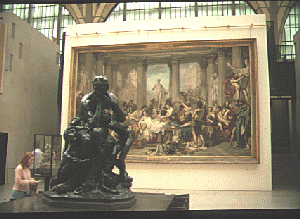 Musée d’Orsay
Musée d’Orsay Once upon a time there was a Palace called the Palais d’Orsay, just across the river from the Louvre. Like many buildings, however, it was burned down in 1871. The site stayed empty until the Great Exhibition of 1900, when the Orleans Railway Company took it over and built a station for visitors to the exhibition. They called it Gare d’Orléans, but Parisians as usual preferred the old name, and it’s always been called Gare d’Orsay.
In 1940 the trains stopped and the station became a prisoner-of-war camp, and then it stood empty. At one point, a theatre company took it over, performing in a huge tent inside the building, but the place was falling down and they moved out. It should have been pulled down, but President Pompidou refused permission, and it has finally re-opened as the Musée d’Orsay, a Museum of the Nineteenth Century. Actually, it covers the years from 1848 (dethronement of Louis-Philippe) to 1914. The building itself is the first exhibit; Art Nouveau style, elegant and grandiose; but its chief glory is the paintings, since its period is exactly that of the Impressionists and their followers; Renoir, Manet, Monet, Toulouse-Lautrec, Van Gogh, Bonnard, you can drown in colour if you’re not careful. Also architectural plans and models, furniture, oodles of sculpture; it carries on nowhere the Louvre leaves off, and does a superb job.
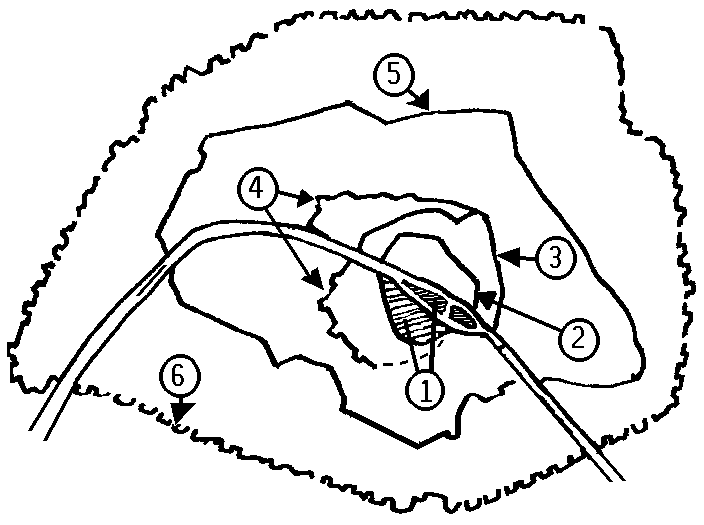
The Romans arrived here about 65 BC, and found a town on the Island now called the +le de la Cité. They took it over and expanded onto the Left Bank - the side nearest Rome - into the area marked 1 on the map. Their baths and Arena, dating from the second century AD, can still be visited. As several Roman roads met here, it soon became a trading centre. Though the town was called LUTETIA, it gradually took on the name of the local tribe, the Parisii.
In the Middle Ages, when nobody was ever quite sure who was King of where - most of France belonged to the Kings of England for most of the time - it was no longer possible for all the inhabitants to crowd onto the island in times of trouble; so in the years 1190 to 1213 King Philippe-Auguste built a wall (2 on the map) round the town for protection against its many enemies. The walls, in fact, were a bit too good at their job; the English came into possession of Paris, and were able to defend it even against Joan of Arc (see RUE DE RIVOLI).
Once Paris became definitely acknowledged as the capital of France, more and more people came to live there and the walls had to be extended. Charles V (1356-83, No. 3 on the map) began a wider enclosure, and Louis XIII continued this in 1633-6 (No. 4). In 1787, however, all these were pulled down because they were now inside the town. In their places, roads were built - the Grands Boulevards - and a new wall went up round the new boundary. This was called the Tax-collectors’ wall (le mur des Fermiers-Généraux), because its purpose was less defence than revenue. At intervals round the walls were toll-gates, some of which still exist, for instance at La Villette, the Parc Monceau and Place Denfert-Rochereau. Anybody who brought goods into Paris had to pay customs duties.
Naturally, this means of increasing royal income did not appeal to the people of Paris, for whom a loaf of bread already cost half a day’s wages. It is no coincidence that the Revolution happened within five years of the wall being completed. After that, the town went on growing - faster, in fact, now the tolls were abolished - and by 1841 new walls were considered necessary for defensive purposes. These (6) were duly built according to the most modern pattern, augmented by a ring of forts a mile outside the walls, whose purpose was to prevent an enemy bringing artillery within range of the city. The tax-collectors’ wall was demolished and turned into an outer ring of Boulevards by Napoleon III. Later, the open-air metro line was built above these boulevards. The metro map show their line very clearly.
The new fortifications came in useful in 1870, when Napoleon III lost the Franco-Prussian War in record time and Paris was besieged by the world’s finest army for six months, finally surrendering out of hunger after eating every sparrow, every rat, and the entire contents of the zoo. The last walls were finally demolished in 1920, their place being taken by a narrow green
belt of parks and sports grounds, and more recently the BOULEVARD Périphérique, a motorway round the entire perimeter. The line of the 1841 walls, however, remains the boundary of Paris, though the built-up area now spreads miles outside into La Petite Couronne - the suburbs - and La Grande Couronne, the satellite towns. Those places where roads - or metro lines - cross the line of the old walls are still called PORTES - gates.
For a more detailed History of Paris, see History of Paris
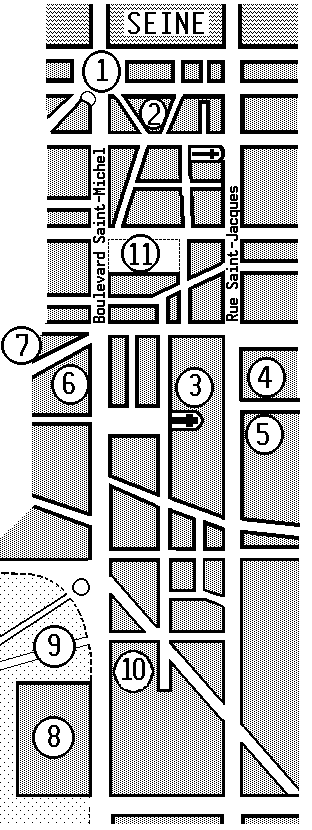
Latin was the language of the Church in the Middle Ages, and that made it the language of Education. Students were taught in Latin, and the University area on the Left Bank is still known as the Latin Quarter. Paris has ten universities, most of them based here South of the river, in the second-oldest part of Paris. The ‘Main Street’ of the Quartier Latin is the Boulevard Saint-Michel, known to all as Boul’Mich. It runs parallel to the Roman main street (Via Superiora) now called Rue Saint-Jacques.
1) Place Saint-Michel has a fountain (statue of St. Michael), trees, bookshops, market stalls. To the West is the area of Saint-André des Arts, full of pavement cafés and clothes shops.
2) The district round the church of St.-Séverin is pedestrianised; full of Greek and Vietnamese restaurants, some with whole pigs roasting in the window.
3) The first University of Paris, founded by Robert de Sorbon in 1253, which is why it’s called the SORBONNE.
4) The second University, Collège de France.
5) Not a university, but a Sixth-form College, Lycée Louis-le-Grand.
6) Lycée Saint-Louis
7) Cordelier University
8) École National Supérieur des Mines - not a University, but one of the Grandes Écoles, which is even better. Graduates of these places run France.
9) Jardin du Luxembourg : The Luxembourg Palace was built in 1615 by a Queen called Marie de Médicis, just as the Tuileries Palace was built in 1563 by Catherine de Médicis. The Medici were Italian bankers, the richest in the world, and whenever a King of France ran out of money he would marry a Medici. The Luxembourg garden is less formal than the Tuileries, though it has more fountains. There’s a puppet theatre here, though, and a truly splendid supervised playground where you can leave your toddlers in complete safety. The Senate, the Upper House of the French Parliament, sits in the Palace itself. To one side of the Palace is the Orangerie, used as an Art Gallery in the summer when the orange trees are out in the gardens; on the other side is the Fontaine de Médicis, a charming pool with marble sculpture.
At the southern end of the garden is the AVENUE DE L’OBSERVATOIRE. This dates from the time when Longitude could be measured, not merely from Greenwich, but from Paris. This avenue, from Saint-Sulpice to the Paris Observatory, runs along the Paris Meridian. A standard METRE was originally defined as one ten-millionth of the distance from the North Pole to the Equator, via this avenue.
10) RER station Luxembourg
11) Musée de Cluny: in Roman times the Island was the seat of government. The real town centre was here, at the Baths. This vast building is mostly ruined, but enough remains to be impressive. The medieval house, Hôtel de Cluny, built next to it is a Museum of the Middle Ages, with some superb tapestries as its star exhibits.
Sainte Geneviève
Opposite the Jardin du Luxembourg is the Rue Soufflot, named after the architect of the Panthéon, the big building at the end of it. To the right of the Panthéon is the church of St.-Étienne-du-Mont.
Once upon a time there was a simple little village girl who saved Paris from Attila the Hun, converted the Frankish King Clovis and became a Saint. Her name was Geneviève, and she is the Patron Saint of Paris. A church dedicated to her was built here, on top of the highest hill on the Left Bank. In the eighteenth century it was decided to build her a really big and impressive church. This was completed, and Geneviève’s tomb moved in, just in time for the revolution, which deconsecrated the church, blocked up the windows and turned it into a Pantheon - a place where the bodies of great men are buried. So the Patron Saint of Paris has no church in Paris. Geneviève’s body was burned, though somebody saved a bit of the coffin. This is still kept in St.-Étienne-du-Mont, my favourite Paris church. I haven’t yet managed to think of an architectural style it hasn’t got. It also has the only rood-screen left in Paris, a highly-carved marble Gothic structure separating the nave from the choir. In the old cloister are some lovely primitive medieval windows. Don’t miss it. The Panthéon itself I find boring, but many people are impressed by it.
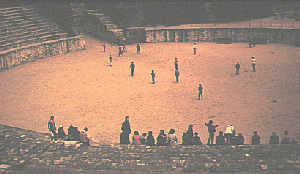 Arènes
de Lutèce
Arènes
de Lutèce
Behind the Panthéon is the LYCÉE HENRI IV, and behind that the ARÈNES DE LUTÈCE. This is the Roman Arena, where gladiators fought and Christians met lions. It was discovered when Napoleon III’s merry men were digging the foundations for one of his broad streets, Rue MONGE. North along this street is the JARDIN DES PLANTES, once the Royal Botanical Gardens. Apart from the wonderful gardens,it has a small zoo, the first in Paris but now just an annexe of the big one at Vincennes, which contains Paris’ oldest inhabitant, a tortoise generally agreed to have been around at the Revolution. Also in this park are a group of Natural History Museums, covering the whole of biology from dinosaurs onwards.
Rue Mouffetard
The way downhill from the arena to the South takes us along the RUE MOUFFETARD, a narrow sixteenth-century street lined with market stalls, very picturesque. At the bottom of that, you are well on the way to PLACE D’ITALIE, another of those star-shaped squares, the centre of a district that has recently been demolished and rebuilt. To the West of this is PLACE DENFERT-ROCHEREAU, remarkable for three things: a) a 17th-century toll-gate b) a statue called LE LION DE BELFORT, recalling the resistance of the town of Belfort in the war of 1870, and c) The entrance to the CATACOMBS. These are old gypsum mines to which, in the eighteenth century, all the boned from the central Paris cemetery were removed. Over a million skeletons here, but piled up neatly by some humorous ghoul and carefully sorted; here a stack of skulls, there a pile of thigh-bones and so on. During the last war, some members of the Resistance made this their headquarters. Ugh.
From Denfert-Rochereau it’s a short walk to PARC DE MONTSOURIS - big, wooded, with grass you can actually walk on,, lots of playspace for kiddies, and very cheap ice-cream; and beyond it the CITÉ UNIVERSITAIRE, a sort of model village for students from all over the world.
R.A.T.P.: RÉGIE AUTONOME DES TRANSP0RTS PARISIENS - Paris Transport Company. S.N.C.F.- SOCIÉTÉ NATIONALE DES CHEMINS DE FER FRANÇAIS - French National Railways. METRO - CHEMIN DE FER MÉTROPOLITAIN - city railway system R.E.R. RÉSEAU EXPRESS RÉGIONAL - Regional Express Network. Soon after we arrive in Paris, you should get a leaflet containing maps of the Metro, the Bus system and the RER. All these are run by RATP sometimes in conjunction with SNCF. Also on the map are the principal stations of the SNCF. Let’s deal with those first.
Britain is an island: from London stations until recently you could catch trains only to other parts of the island. But from Paris you can catch trains to places thousands of miles away. Most English people arrive at the GARE DU NORD. From there you can go to the Channel Ports, Holland, North Germany and Scandinavia. Down the street is the GARE DE L’EST; Trains to Berlin, Prague, Vienna, Budapest, Athens, Istanbul, warsaw, Moscow, Vladivostok and Peking.
From GARE DE LYON you can go to Switzerland, Italy - on the Orient Enpress if you like - or to the South of France on the TGV, the world’s fastest train. From GARE D’AUSTERLITZ trains go to Spain and Portugal; from GARE SAINT-LAZARE to Normandy, Brittany and the rest of France.
There are many other SNCF stations in Paris, serving the towns and villages of the Paris Region. These are gradually becoming part of the R.E.R, a brand new suburban commuter service, with more lines being built all the time. At the moment there are three lines, with four or five more due to open soon . The two main North-South and East-West lines meet at CHATELET LES HALLES, a hundred feet under the centre of Paris -ultra-modern, streamlined, no-expense-spared, all stainless steel and bronze. Trains come about every 5-10 minutes on each line: the busier the time of day the longer the train.
The METRO is older, but here too new lines are being built, and every station is being modernised. In the whole of Paris, you are never more than 500 metres from a metro station. The fares are ridiculously cheap, as the price is the same wherever you go. Tickets can be bought singly or in CARNETS. A Carnet is a set of ten tickets, costing the same as six bought singly. Once you have your ticket you need to know in which DIRECTION you’re going. There are maps everywhere, on which you find the name of the station at the end of the line. If you are in the centre of town and want to get to GARE DU NORD, you follow the signs reading DIRECTION PORTE DE CLIGNANCOURT, because you want to go towards Porte de Clignancourt and get off at Gare du Nord. Following the signs, you’ll come to an automatic barrier. Put your ticket in the slot, it’ll let you through and hand your ticket back at the other Side. Hang onto your ticket; there are heavy fines for travelling without. When you reach the platform, no problem. The next train is going your way: it’ll come from the left: there’ll be a train every two minutes at rush-hour, and you ’ll never have to wait longer than ten minutes.
When you get off, follow signs again: CORRESPONDANCES if you want to change trains, SORTIE if you want to go out. You can ride around all day on one ticket, but once out of the SORTIE you can’t get back without another.
A Metro ticket entitles you to travel anywhere in Paris by Metro, RER or Bus. Long Bus journeys, however, cost two or three ticket. Buses are as frequent as trains -every two minutes at busy times; there’s a machine to check your ticket inside the Bus. The system is cheap because it’s simple and everybody uses it, though it is subsidised as well. Every year the RATP carries as many passengers as there are people in the world. Basically, however, The Metro is cheap because everybody uses it; and everybody uses it because it’s cheap.
The French Revolution is a misleading term. There have been at least 23 French Revolutions. The first one started on 14th July 1789 when the starving people of Paris attacked the Bastille, a fortress on the edge of town, because a) they needed some guns and b) the Bastille was a prison where the King could send anybody, any time, without question or trial. The mob, armed with muskets and one or two cannon from Les Invalides, battered at the walls and told the Governor that his life would be spared if he surrendered. The Governor surrendered. His head was removed with a blunt knife. The mob then rushed to rescue the prisoners. It turned out there were only seven of them, as the King wasn’t using that prison any more. Bother.
Meanwhile at Versailles the King, wanting more tax money, had called Parliament to meet for the first time in 150 years. Mistake. In theory, he should have got what he wanted. Parliament had three houses, or ‘Estates’; the Nobility, the Clergy and the Third Estate, which meant the common people. (Incidentally, this is where we get the term ‘Third World’ from.) The Nobility and Clergy didn’t pay taxes, so were only too willing to give the King what he wanted. The Third Estate paid all the taxes and would obviously vote against more; but each Estate had only one vote. The members of the Third Estate responded to this constitutional unfairness by locking themselves in the King’s indoor tennis court and swearing not to leave until France had a new constitution. The King gave in, then changed his mind, then sent for troops to back up his authority; which was why the common people in Paris needed guns to defend themselves.
When the King heard about the Bastille business he said ‘Oo dear, is this a revolt?’ and was answered ‘No, Sire, it’s a Revolution’. He allowed the Third Estate a new voting system, but they didn’t trust him and he was escorted to Paris where an eye could be kept on him. He tried to escape and was imprisoned. Every other King in Europe protested. The new French Government declared war on every King in Europe. The King was convicted of plotting with France’s enemies, and guillotined. Reign of Terror. All enemies of Revolution go on chopping list. Enemies defeated. War over, Terror no longer necessary, its leaders are executed. France without leaders, General Napoleon Bonaparte takes over. 1804, he becomes Emperor Napoleon. More wars. 1814, King back (Louis XVIII); 1815, Napoleon returns for 100 days, then Waterloo and King back. Succeeded by his son Charles X. Unpopular. 1830, Revolution. Louis-Philippe, constitutional monarchy. 1848, Revolution. Second Republic. President, Louis-Napoleon Bonaparte, great-nephew of guess who. 1852, Second Empire, Napoleon III. 1870, war with Prussia. France loses. Paris besieged. Emperor abdicates. Third Republic. New Government surrenders Paris. Revolution in Paris (the Commune). French army invades Paris. 20,000 Parisians killed in a week. Paris comes to heel. 1940, Germans invade. Dictatorship. 1945, Fourth Republic. At the moment, we’re on the Fifth Republic and still counting.
The whole street was Napoleon’s idea. Rivoli is a place in Italy where he won a battle, and he was impressed by the shady arcades along the streets of Italian towns. Rue de Rivoli has arcades along its North side all the way from Place de la Concorde to Place du Louvre - perhaps more useful here for keeping off rain than sun, but very pretty. It never became the main street of Paris, as Napoleon intended, but a walk along it is a good introduction to the town. Let’s start from the Place de la Concorde.
Apart from W.H.Smith’s bookshop and the view up
to the Place Vendôme (see page 56), the main feature of the
first few hundred yards is the Jardin des Tuileries (see page 24) on
the right. The real sightseeing begins at No. 1 on the
map. 
This is PLACE DES PYRAMIDES, a neat square with arcades all round, and in the centre a gilded statue of Joan of Arc, who arrived here in command of the French Army in 1430, and near this spot was wounded by an arrow while testing the depth of the moat with her spear. The English, who’d never even scratched her before, were delighted, and she never managed to capture Paris.
For the next half-mile the South side of the
Rue de Rivoli consists of a single building, the Louvre, which has
its own page; we’ll concentrate here on the North side. No.3 on the
map is one of my favourite places, the PALAIS-ROYAL.
 This was built in 1632
for Cardinal Richelieu, who was governing France on behalf of the
young Louis XIII, and was called the Palais-Cardinal. When Richelieu
died he left the palace to to the King, who had his own palace across
the road and never used the place. On the death of Louis XIII,
however, his widow Marie de Médicis moved in with her
five-year-old son. As the toddler in question was now - and would
remain for over 70 years - Louis XIV, the Palais-Royal became a Royal
Palace for the first and last time in its history. Louis XIV soon
grew up and moved out, and the Palace passed to his brother and his
descendants the Orléans family, who kept it till the
Revolution. The Duke of Orleans under Louis XV opened the garden to
the public and built the row of shops which surrounds it. (‘Now that
our cousin has gone into trade’ quipped the King, ‘I suppose we’ll
only see him on early closing day.’ All the courtiers laughed like
drains. This is the only recorded example of a joke cracked by a King
of France.)
This was built in 1632
for Cardinal Richelieu, who was governing France on behalf of the
young Louis XIII, and was called the Palais-Cardinal. When Richelieu
died he left the palace to to the King, who had his own palace across
the road and never used the place. On the death of Louis XIII,
however, his widow Marie de Médicis moved in with her
five-year-old son. As the toddler in question was now - and would
remain for over 70 years - Louis XIV, the Palais-Royal became a Royal
Palace for the first and last time in its history. Louis XIV soon
grew up and moved out, and the Palace passed to his brother and his
descendants the Orléans family, who kept it till the
Revolution. The Duke of Orleans under Louis XV opened the garden to
the public and built the row of shops which surrounds it. (‘Now that
our cousin has gone into trade’ quipped the King, ‘I suppose we’ll
only see him on early closing day.’ All the courtiers laughed like
drains. This is the only recorded example of a joke cracked by a King
of France.)
At one of these shops, in those days a café, Camille Desmoulins leapt onto a table in July 1789 and suggested to the locals that it might be a good idea to storm the Bastille. During the First Republic and the First Empire, the garden became a sort of open-air club, the shops turned into gambling-dens, and the less said about what went on upstairs, the better.
When all this was forced to close down in 1830, Louis-Philippe having come to the throne and being not only respectable but also head of the family that owned the place, it became the cool, quiet, charming place it is today. The bars closed, the shops began to specialise in medals and coins for collectors. There are flats above the shops, much favoured by literary people but horrifyingly expensive. There are trees, pigeons, fountains, shade, nannies and prams. The main building is occupied by the Conseil d’État, a constitutional body of the most boring kind; its courtyard has been invaded by a strange sculpture consisting of striped black and white columns, known to English schoolchildren as ‘The ‘Umbugs’. There is a sort of well here, where tourists throw coins, so this is one of the places where Parisian small boys practise coin-fishing; French ‘silver’ coins are made of stainless steel, and can be collected with a magnet on a piece of string.
No. 3 on the map, attached to the Palais-Royal, is the COMÉDIE-FRANÇAISE, one of the French National Theatres, where the great Classical plays are performed. The charming square next to it at the bottom of the Avenue de l’Opéra is named after the writer Colette, long a resident of the Palais-Royal.
4: At the corner of Rue Marengo, a clump of little shops includes the BAZAR MARENGO, owned by my friend Jamin and run by his family. This is where to buy the cheapest postcards, souvenirs and T-shirts in town. Don’t you dare buy them anywhere else. Showing this guide will guarantee a warm reception.
The Louvre finally comes to an end in an open
space between Rue de Rivoli and the river. This is the Place du
Louvre, dominated by the colonnade of the Louvre at one side and on
the other two quite similar buildings. No.5 on the map is the church
of Saint-Germain-L’Auxerrois, once the Parish Church of the Louvre.
Superb Gothic porch, very fashionable place to get married. Next
door, the 19th-century pastiche of St.-Germain is the Town Hall
(Mairie) of the 1st Arrondissement. Paris is divided into 20
Arrondissements, each with its Town Hall and Council. The steps down
into the ground in front of this lead to the car-park of
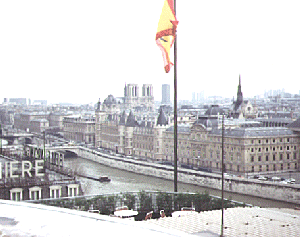
6: The SAMARITAINE Department Store - four whole blocks of it, with a basement extending under all four and all the streets between. The underground car-park spreads, as we have seen, even further. The Samaritaine sells absolutely everything, at all prices from cheap to ridiculous. A visit to this store is COMPULSORY for all visitors, because from the 10th floor of Shop No. 2 (the one by the river) you can go up a flight of stairs to a café terrace, and another spiral staircase to a viewing platform with one of the finest views in the world.
If you’re scared of heights, go all the same. The viewing platform is only a few feet above the flat roof, so you can’t look straight down; I’ve taken hundreds of people up here, children and adults, and not one of them has ever got vertigo. Round the edge of the platform is a panoramic picture of the view, a little out of date now, with all the buildings labelled. You are higher than the houses but lower than the great monuments, and just opposite the point of the +le de la Cité, in the very centre of Paris. Gaze for hours. nip downstairs, buy a coffee and gaze sitting down. It’s the greatest show on earth.
7: One of the things you can see best from up there is the PONT-NEUF leading to the Île de la Cité;
Once down to earth, there’s still more to see along Rue de Rivoli; but between 7 & 8 on the map, go along the Quai de la Mégisserie, especially if you’re a gardener or an animal-lover. The shops here sell animals, plants and tropical fish; there are cages and flower-beds on the pavement. The goods are ferociously expensive, but you can’t take them home anyway, so do what everybody else does; hold up the traffic while you say ‘Aaaah’.
8) PLACE DU CHATELET was once the site of a small castle famous for its torture-chamber. It is now an impressive square, floodlit at night, with an enormous theatre at each side, a fountain commemorating Napoleon’s victories in Italy and Egypt, and a view clear across the +le de la Cité past the Conciergerie along the old Pilgrims’ road from
9) the TOUR SAINT-JACQUES. In the Middle Ages, instead of package tours, people went on pilgrimages. But they still mostly went to Spain, to the shrine of Santiago de Compostela. Sant’Iago = Saint-Jacques = Saint James. The pilgrims would start here, the first of a string of St.James’ churches. The old road still leads straight as an arrow across the island and away to the South. The pilgrims travelled in groups for fear of robbers, and at intervals of a day’s journey there were monasteries where they could stay the night. If you made it there and back, you were allowed to wear a badge showing a cockleshell, the medieval equivalent of an ‘I’ve been to Santiago’ T-shirt.
Why is there a tower and no church? Well, during the Revolution the Town Council raised money by selling church property. The church of Saint-Jacques-la-Boucherie was bought by a manufacturer of lead shot, which you do by dripping molten lead down the inside of a tower. He demolished the church because it was in the way, and removed the various floors in the tower by the simple expedient of cutting the bells loose at the top. This must have caused one of the finest sound-effects in history.
At the foot of the tower is a statue of Blaise Pascal, scientist and philosopher. The statue was placed here because it was known that Pascal did some experiments on atmospheric pressure on the tower of Saint-Jacques. It later turned out that he did them at an entirely different Saint-Jacques, but that’s life all over.
10) PLACE DE L’HÔTEL DE VILLE. This was once called Place de Grève (Sandy beach square), and was where the unemployed used to meet; which is why the French word for a strike is grève. It was also used for the more spectacular and messy public executions, such as those of Ravaillac, who killed King Henri IV, and Damiens, who scratched Louis XV. Both spent half a day here having lumps torn out of them with pincers and the holes filled up with molten lead, before having each limb attached to a different horse.
Along one side of the square is the Hôtel de Ville, the Town Hall of Paris. This building dates from 1875, when it replaced a similar one burnt down in the last days of the Commune. The whole square has recently been cleaned and tarted up, and supplied with a raised terrace with a string of rather uninspired fountains at each side.
Rue de Rivoli ends soon after this, continuing as the Rue du Faubourg Saint-Antoine; see the sections on the MARAIS and BASTILLE.
 Sacré-Coeur
Sacré-Coeur
On top of the Butte Montmartre stands, like a huge stone wedding-cake dominating the North of Paris, the Basilica of the Sacred Heart. A basilica is an enormous church which isn’t actually a cathedral because no Bishop has his throne there. This one is newer than it looks. It was built as an ‘Act of National Repentance’ after France declared, fought and lost the Franco-Prussian war in 1870, and it was finished in 1919, when the provinces of Alsace and Lorraine, taken into Germany in 1870, were returned to France. I think it’s impressive but ugly; other people have other opinions. To reach the entrance you can spend a metro ticket on the Funicular railway that climbs the hill, or you can walk up the 400 steps. Once inside, another 300 steps will take you up to the dome, where you’re nearly as high as the Eiffel Tower. This, however, is a fairly pointless activity, since even from the bottom step the view over Paris is stunning. Get there, if you can, at dusk; watch the sun set and the lights come on. You’ll never forget it. Behind the church is the bell-tower, in which hangs La Savoyarde, one of the world’s largest bells. It weighs 19 tonnes. Also at the top of the hill you’ll find a reservoir for the drinking-water of Paris and the old village Church of Saint-Pierre, which is charming.
Shopping
Paris is the world’s greatest shopping centre, but you have to know your way around if you’re not going to pay millionaire’s prices. A can of coca-cola, for example, bought in the Jardin des Tuileries, costs the same as a two-litre bottle bought in a supermarket near the Gare du Nord. Paris shopping, basically, falls into four groups:
1) Souvenirs and postcards. You find these everywhere, but I’ve never got better value than at the BAZAR MARENGO opposite the Louvre (see page 21).
2) Snack meals. If you’re staying in a hotel outside the Grands Boulevards (probably near the stations, or in Montmartre or Vaugirard), go to the local supermarket before you set out for the day and buy the materials for a picnic; or to the local baker or charcutier, who will sell ready-made sandwiches cheaper than in the centre of town. But if you’re already in the centre, and you really want a picnic, do as follows; First, find your way to the Palais-Royal (see page 20). Go into the garden and past the fountain. On the left , towards the far end, a tunnel passes through the buildings. Go through the tunnel and you’ll find yourself in a little narrow street. Almost opposite you some steps lead up to an alleyway which leads to the next street. This is Rue de Richelieu, and just opposite you begins Rue Molière; there’s a statue of Molière (17th-century dramatist, wrote great comedies) to prove it. In front of you, where the two streets meet, there’s a little charcuteries that sells such cooked meats, such made-up salads, such prepared dishes as populate the dreams of gourmets. There’s a good baker’s to the right as well. Bon appétit!
3) General shopping, including wines etc. to take home. Take a trip on the RER to La Défense (see page 43). You’ll save your fare by shopping at AUCHAN, the hypermarket there. Alternatively, nip out to the end of almost any metro line and you’ll find a suburban shopping centre with a large supermarket. Terminal 93 at Porte de Montreuil, for instance, or the Carrefour at Gennevilliers.
4) Prezzies to take home. The one place in Paris where you can guarantee to find absolutely everything is the Samaritaine; see page 22. If you like cuddly toys, the Samar has enough to start a zoo, a farm, a kennels and a cattery; a cuddlers’ paradise.
SMALL PERSONS: What are you taking home for Mum?
If you must but a gold-plated plastic miniature Eiffel Tower, I suppose you must; but don’t buy it on the Tower itself unless you have money to burn.
All Mums like French perfume; but they like the real thing, which comes in a plain, elegant bottle (not one shaped like the Eiffel Tower or Madonna), and costs about £20 a time. It’s cheaper if it’s less strong and called Eau de Toilette, or even weaker and called Cologne - and it still smells as nice.
As well as the above, however, one of the great pleasures of Paris is window-shopping. Boulevard Haussmann is a good place for this, with PRINTEMPS and GALERIES LAFAYETTE – and Marks and Spencer, opposite.
Some bargains can be obtained in the MONOPRIX built into the middle of Galeries Lafayette. The FORUM DES HALLES is generally good to look at but expensive. If you walk down the CHAMPS-ÉLYSÉES from the Arc de Triomphe on the left-hand side, there is a succession of three or four arcades worth seeing; expensive naturally, but each has a central feature - a water clock, a perpetual-motion machine, a cascade. Avoid the DRUGSTORES here, unless it’s two in the morning and everywhere else is closed; prices are geared for that exclusive market. The shopping centre at Montparnasse, with its branch of Galeries Lafayette, has its moments too. However, in all these places you will find shops of two chains which offer value for money: PIER IMPORT sells all manner of goods imported from the Far East, including much that, while obviously not French, is made to suit French taste; and JIMBO is a good toyshop.
Last of all, the cheapest of the cheap: TATI sells clothes in chic candy-striped carrier bags at prices you won’t believe; branches near metro stations Barbès-Rochechouart and République; and a place called the Élysée Bazar, opposite the entrance to La Villette, deals in cheap stationery, toys, pictures, videos, everything.
Where the Rue Saint-Denis meets the Boulevard de Strasbourg, about half a mile down the street from the Gare du Nord, is nowadays the centre of the rougher side of Parisian night-life, so it’s not a place recommended in the evenings. Even at High Noon, those easily shocked are going to be shocked in this area, but there are several points of interest if you can manage to concentrate your attention.
1) PORTE SAINT-DENIS and PORTE SAINT-MARTIN - two triumphal arches built by Louis XIV as toll-gates in the walls around the town. North of here was the suburbs, les faubourgs; see how the streets change their names as they pass through the arches; Rue Saint-Denis south of the arch, Rue du Faubourg Saint-Denis to the North; and the same for Rue Saint Martin and Rue du Faubourg Saint Martin. The road where the walls used to be is, of course, a Boulevard - a bulwark.
2) CONSERVATOIRE NATIONAL DES ARTS ET MÉTIERS on the Rue Saint-Martin. This institution houses the old Musée des Techniques, the Technology Museum. Machinery from the early industrial revolution, the first aircraft to fly the channel, Cugnot’s unworkable steam carriage that was the first self-propelled road vehicle, and a statue of Denis Papin, the Frenchman who invented the steam engine. And all those years you thought it was a Scotsman.
3) LES PASSAGES a fascinating maze of covered arcades, forming probably the world’s first shopping mall. Most of the passages specialise; many sell books or stamps and coins for collectors. One is full of shops which sell nothing but display materials for other shops, so you can go window-shopping in the shop window of a shop window shop.
The area covered by the passages was always a maze of tiny streets. In the Middle Ages it was called the Court of Miracles; a no-go area for the authorities, where thieves and beggars lived. In the evenings, miracles happened here. Beggars who had been blind all day suddenly recovered their sight; lame ones walked, scars vanished. Infirmities, however, always seemed to return in time for the next day’s begging.
The string of passages leads towards the Rue Lafayette through a district called Le Sentier, the heart of the Paris garment industry. All those fabulous hand-sewn dresses are hand-sewn in dingy workshops round here. Before sewing-machines were invented, this was home to thousands and thousands of young girls who sewed all day for pitiful wages. They used to supplement their meagre pay by picking up men during their two-hour lunch-break, and became known as les midinettes - the noontime girls. Their great Festival and day off was St. Catherine’s Day, 30th April; and if you follow the passages all the way to Rue Lafayette, you’ll come out at Square Montholon, a nice little park with a children’s playground and, next to the sandpit, a delightful statue entitled ‘Saint Catherine’s Day’ and dedicated to the Parisian working girl. It shows a bunch of them, plumply pretty, overdressed even for 1890, having a whale of a time and no better than they should be. Don’t miss it.
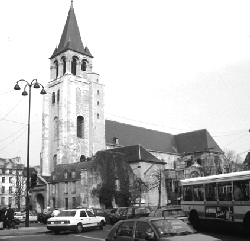
The BOULEVARD SAINT-GERMAIN runs from the Pont de la Concorde round the Left Bank to the Pont Sully opposite the +le Saint-Louis, but the district known as Saint-Germain lies along the Boulevard to the West of the Boulevard Saint-Michel, between the Invalides and the Luxembourg. It is a district of great town houses like the Musée Rodin, many of them now Government Ministries. Biggest of all is the PALAIS-BOURBON, built in 1722 for the Duchesse de Bourbon, daughter of King Louis XIV (but not, alas, of the Queen). In 1784 it was bought by Louis XVI because he needed to alter the back. This overlooked the new Place de la Concorde, and had to be changed to match the buildings across the square. So a new front was built onto the back of the palace, and it became the only building in Paris with two different fronts and no back. In 1807 Napoleon had the Concorde front altered again, to echo the Greek-temple appearance of the Madeleine. Since 1827 it has been the home of the Assemblée Nationale, the French equivalent of the House of Commons. Perhaps it would be unfair to suggest that a building is ideal for use by politicians which has two faces, both different, and no back to be stabbed in.
The Church of Saint-Germain-des-Prés is the oldest church in Paris. Originally - it was founded in 542 - it was, as its name implies, ‘in the fields’. It was destroyed by Vikings (they get everywhere, don’t they?) and their successors the Normans several times over, and the present building was started in 990 in the Romanesque (round-arched) style of the time. The Choir was rebuilt in the 12th century, and is Gothic, with pointy arches.
The Church of Saint-Sulpice was built over a period of 134 years by six different architects. The last phase of building, begun in 1732, never got finished, so the two western towers don’t match. In the end, it’s a great echoing barn of a place, famous for two things; first, the sound of its organ, which has been the preferred instrument of generations of great French composers (Widor, Franck, Dupré); and second, for the kind of sentimental religious art which produces droopy plaster saints. The Lady Chapel is a splendid example of this genre, and the square outside is surrounded by shops selling holy medals etc. This sort of art, indeed, is known in French as ‘sulpicien’. Also in the square is rather a nice fountain with four stone bishops sitting on thrones, water running out beneath them.
Streets in French towns are usually named after people - Avenue Victor-Hugo, Rue Bonaparte - or historical events, including, confusingly, dates like Rue du 8 mai. At each end of the street, however, is a blue plate explaining who the person or event was and when he or it lived or happened.
There are various different kinds of streets, squares and large buildings:
UNE RUE is a street, with houses on both sides, leading nowhere in particular.
UNE AVENUE is the road by which a town is approached. Plainly, as a town gets bigger the avenues are swallowed up inside it; but they still usually have trees on each side to shade the traveller, and run from the centre of town outwards.
UN BOULEVARD, on the other hand, runs round the town. It is a street laid out where the walls used to be. Paris, by the way, is a town, not a city; municipal property is labelled ‘VILLE de Paris’. Technically, a city is a town with walls round it. Paris nowadays has ring roads instead.
UNE PLACE is a Square; an open space where several roads meet. Often there’s a statue in the middle, and of course it can be any shape, not just square. Circles, octagons and half-moons are common in Paris.
UN SQUARE, confusingly, isn’t square either, and isn’t a square. It’s a tiny park, like those in the middle of some London Squares. Sometimes it has fountains, always trees, grass not for walking on, a sandpit and climbing-frame for children, special gates to keep out unleashed dogs, and a uniformed attendant with a whistle to blow at naughty children and English people walking on the grass.
UN HÔTEL is any big house in a town, just as a big house in the country is Un Château whether it’s a castle or not. Un Hôtel can be a Town Hall, a Nobleman’s residence, a library, a Tax Office, even an hotel. A really enormous building is called UN PALAIS, except for a really enormous hotel (like the Ritz), which is called UNE PALACE.
UN PASSAGE is an alleyway leading from one street to another, often covered and sometimes lined with shops.
UNE IMPASSE is a street with no way out. In English we call this a cul-de-sac, which would be French for the bottom of a bag, only the word cul is far ruder than ‘bottom’.
UN COURS is a broad avenue, usually with houses only on one side (perhaps a park on the other) where noble ladies used to drive or ride. Cours la Reine, along the river from Place de la Concorde, was specially built for a new Italian Queen who arrived in Paris with a carriage which was too wide for the streets.
UN QUAI is a road running alongside a river or canal.
UNE PORTE is a gate; but now Paris has no walls, it’s a square where the gate used to be. Look at your metro map; all round the edge of Paris there is a series of Portes. There’s even a bus called the PC (petite ceinture) which goes round them all in a few hours.
This elegant square, between the Opéra and Rue de Rivoli, houses the Ritz Hotel and the British Tourist Office, among other extremely upmarket institutions. It was originally built to surround a statue of Louis XIV. The enormous, out-of-scale column now in the centre (144 feet high, when the square was designed round a 20-foot statue) was put there by Napoleon I. 1,200 bronze cannon captured at the battle of Austerlitz were melted down to make the sculptured triumphal procession which winds its way from bottom to top.
The statue of Napoleon dressed as Caesar on top of the column was destroyed after Waterloo and replaced by one of Henri IV, later by a huge fleur-de-lys, the symbol of Bourbon monarchy. Louis-Philippe, who replaced the Bourbons in 1830, replaced the statue too, with one of Napoleon in uniform. When Napoleon III took over from Louis-Philippe, he put up the present copy of the original. In 1871, during the Commune - the Parisian revolution which followed the war of 1870 - the painter Courbet, as Minister for the Arts, simultaneously expressed his opinion of Emperors and of monuments out of scale with their surroundings by having the column pulled down (with a very satisfying thud). Unfortunately, the Commune was suppressed, and the new government sent Courbet a repair bill which drove him into exile.
Kink Louis XIV, who reigned longer than any other King in history, had big ideas. One of them was that the whole of the nobility ought to live with him in his palace, where he could keep an eye on them. As the Louvre was too small, he began a new palace at Versailles, ten miles out of Paris to the South-West. 2000 rooms, and a garden with a pond a mile long. Room for everybody, if a bit cramped. If you were a Duke you might get three rooms to live in and the supreme honour of holding the King’s shirt when he got dressed. Everything the King did, he did in public. Often twice, to fit in all the spectators. Going to bed he did three times, because once the public ceremony was over, he was up and off again on, er, unofficial business. Dotted round the garden are smaller palaces for the King’s lady-friends, and later Marie-Antoinette (Mrs. Louis XVI, got chopped in the Revolution) added her own little house so she could play at being an ordinary housewife (it only had ten bedrooms), and her own little village, LE HAMEAU, where she could play at being a milkmaid. The girl was sick, but the village is charming.
The park and gardens were laid out by Le Nôtre, the greatest of all French gardeners, and are full of statues, fountains, arcades, grottoes and temples. the fountains are turned on only a few times a year. Even in Louis XIV’s time there was never enough water, so they turned on only the ones the King could see from wherever he happened to be standing. Entrance to the park is free except when the fountains are on. The Palace is a State Museum, so free to students; some rooms are simply open, others part of a guided tour. If you have to choose one or the other, take the park every time.
La
Villette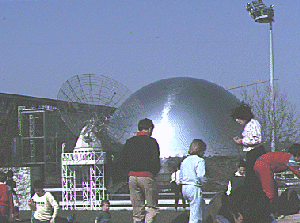
When the Central Markets moved out of Paris, they left three gaps behind. The fruit and vegetable market has been replaced by the Forum des Halles (page 17); the Southern Cattle Market is now the Parc Georges Brassens, (page 57); but the biggest of all, the Abattoirs of La Villette, has seen the most spectacular transformation.
The principal features of the old abattoirs were the two market halls - one for sheep, one for cattle; vast cast-iron and glass buildings which, unlike those at Les Halles, have been preserved. The Cattle Hall encloses a space about the size of four football pitches. It has been used by Unions for mass meetings for some years, and continues to serve that purpose; but the sides of the building have been split into a host of small exhibition halls, studios, offices, etc., including a photographers’ gallery. The open spaces of the area, where the animals used to be kept between market and slaughter, are now a park; on a little hill stands the DRAGON, a vast wood and metal sculpture you can climb all over, with the longest slide in Paris for its tongue. Where the animals used to become meat are new buildings; an inflatable concert-hall (6,000 seats) for pop concerts and a multi-screen cinema among others; but the biggest and best of all is the CITÉ DES SCIENCES ET DE L’INDUSTRIE, a really enormous Science and Technology Museum that’s not about the history of Science, but about science NOW. The Aerospace section is particularly spectacular. Lots of hands-on demonstrations here, audio-visuals in plenty. Even those who don’t speak French can get a lot out of this place.
The same goes for LE GÉODE, the simplest building in Paris; a hundred-foot stainless steel sphere. Very shiny, though heaven knows how they keep it polished. Inside it is one of those cinemas where the film is projected all round the spectator, who cringes in his reclining seat and really gets into the centre of the action.
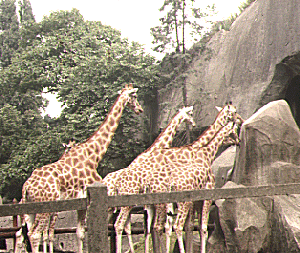 Vincennes
Vincennes
Though Vincennes is outside the walls, it belongs to Paris. It has two main attractions:
The Château de Vincennes; The keep was built in 1370, more buildings added 1652-1660 for Louis XIV’s honeymoon. The keep was a prison from 1500 to 1784; D’Artagnan, the well-known musketeer, was Governor at one time. Napoleon had the Duc d’Enghien shot in the moat, which has always been dry. In 1840 the castle was extended into an enormous fort. Retreating Germans blew up most of the new bits in 1944.
The BOIS de Vincennes; 2,200 acres of woodland, with sports grounds, lakes, a Floral Park, waterfalls and one of the great zoos of the world; 200 species of animals in 42 acres. The Panda is called Yen-yen. No bars in this zoo, landscaped paddocks surrounded by moats, artificial rocks everywhere, one of them 236 feet high with a lift inside and a view of Paris at the top. Well worth an afternoon, but avoid the Sunday crowds.
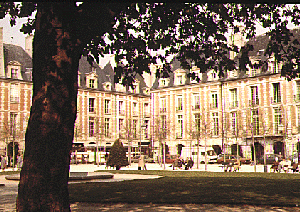 Place des Vosges
Place des Vosges This lovely old square is unusual for Paris in that its houses are faced with red brick. Henri IV started building it in 1605; it was finished in 1612 and hasn’t changed much since, though over the last few years it has been thoroughly cleaned and restored. It was the first Paris square to have all its buildings in the same style. Sheltering galleries overhang the fronts of the ground floor shops. The main building, La Maison du Roi, was intended for Henri IV himself, but he was killed before he could move in. The statue in the middle, among the children’s playgrounds and shady walks, is of Louis XIII.
Until 1800 the name of the Square was Place Royale, but in that year it was renamed in honour of the Vosges, the first part of France to pay taxes to the new Government.